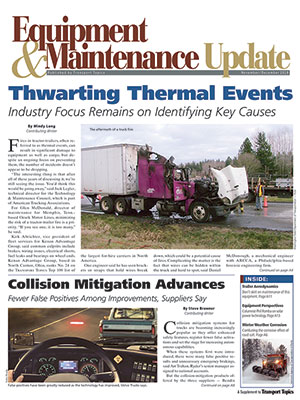Features Editor
Tinkering Toward Improved Truck Safety Technology
Advancements in technology in a variety of everyday applications positively impact us as we live in the 21st century. Technology innovation, including in the trucking industry, is a good thing.
However, broadly speaking, there are instances in which some things can be tinkered with so much to the point that they become too “techy.” This winds up making what should be the simplest of functions more time-consuming and complex than they should be.

Matso Lysiak
One example: touchless water faucets. You, too, may have experienced this annoying situation I’ve encountered on more than one occasion. You go to wash your hands. You place them directly under the spout, expecting the water to flow. But nope — no water. You try again, and sometimes again, waving your hands back and forth under the spout, until finally, the faucet activates.
You can then perform this simple — and necessary — everyday task.
On some days, I’d appreciate the time-saving, hassle-free traditional faucet. These touchless faucets, on the other hand, pun intended, are not so simple, involving electricity and sensors. In my view, they represent the perfect example of too much tinkering.
Turning to trucking technology, among the major innovations in recent years have been collision mitigation systems. These active safety systems, as they also are known, rely on the use of radar sensors and, increasingly, on cameras as well.

- Collision Mitigation Advances
- Thwarting Thermal Events
- Here Comes the Sun
- The Analytical Dilemma
- Preventive Maintenance Helps Stop Rust Due to Road Salt
- Investigating Thermal Event Causes Is Crucial, Experts Say
- Tire Monitoring and Inflation Systems Can Lead to Fuel Savings, Longer Tire Life
- Seeking Alternative Solutions to Salt
- Don't Skirt Proper Maintenance on Trailer Aero Devices, Experts Say
Earlier this year, a session at the fall meeting of American Trucking Associations’ Technology & Maintenance Council addressed some of the maintenance challenges of these systems. According to the meeting program, improvements could be implemented to address potential issues with false activations associated with curved roads and overhead objects, for example, a recent study by the National Highway Traffic Administration found.
These safety technologies are the topic of a cover story in the November-December 2018 edition of Equipment & Maintenance Update.
The story addresses false activations — and, according to the major suppliers of these systems — improvements are underway to make collision mitigation technology better by reducing the frequency of these false positives.
Volvo Trucks, the story notes, became the first North American manufacturer to make the Bendix Wingman Fusion system a factory-built standard on its highway models, which it integrates through its Volvo Active Driver Assist system.
“Those false positives have been reduced drastically with the addition of the camera,” said Ashraf Makki of Volvo Trucks.
At least one fleet, though, reports problems making these systems work with a certain type of equipment.
Read the story to learn more about the improvements to these safety technologies, as well as some of the continuing challenges.
When it comes to safety and trucking, too much tinkering, ultimately, could result in a very good outcome.




